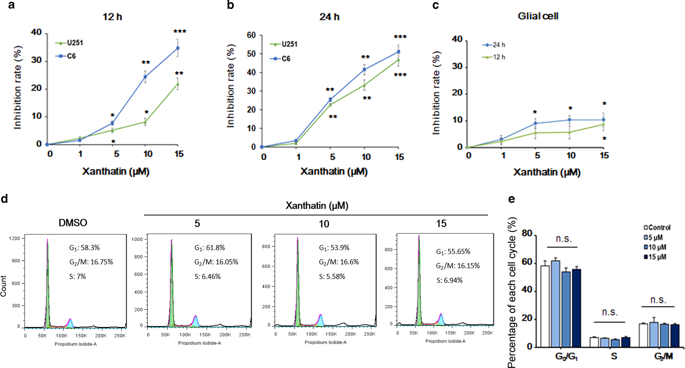当前位置:
X-MOL 学术
›
Acta Pharmacol. Sin.
›
论文详情
Our official English website, www.x-mol.net, welcomes your
feedback! (Note: you will need to create a separate account there.)
Xanthatin induces glioma cell apoptosis and inhibits tumor growth via activating endoplasmic reticulum stress-dependent CHOP pathway.
Acta Pharmacologica Sinica ( IF 6.9 ) Pub Date : 2019-11-07 , DOI: 10.1038/s41401-019-0318-5 Yu-Yang Ma 1, 2 , Ze-Min Di 1, 2 , Qing Cao 1, 2 , Wen-Shuang Xu 1, 2 , Si-Xing Bi 1, 2, 3 , Ji-Shuang Yu 1, 2 , Yu-Jun Shen 1, 2 , Yong-Qiang Yu 3 , Yu-Xian Shen 1, 2 , Li-Jie Feng 1, 2
Acta Pharmacologica Sinica ( IF 6.9 ) Pub Date : 2019-11-07 , DOI: 10.1038/s41401-019-0318-5 Yu-Yang Ma 1, 2 , Ze-Min Di 1, 2 , Qing Cao 1, 2 , Wen-Shuang Xu 1, 2 , Si-Xing Bi 1, 2, 3 , Ji-Shuang Yu 1, 2 , Yu-Jun Shen 1, 2 , Yong-Qiang Yu 3 , Yu-Xian Shen 1, 2 , Li-Jie Feng 1, 2
Affiliation

|
Xanthatin is a natural sesquiterpene lactone purified from Xanthium strumarium L., which has shown prominent antitumor activity against a variety of cancer cells. In the current study, we investigated the effect of xanthatin on the growth of glioma cells in vitro and in vivo, and elucidated the underlying mechanisms. In both rat glioma C6 and human glioma U251 cell lines, xanthatin (1-15 μM) dose-dependently inhibited cell viability without apparent effect on the cell cycle. Furthermore, xanthatin treatment dose-dependently induced glioma cell apoptosis. In nude mice bearing C6 glioma tumor xenografts, administration of xanthatin (10, 20, 40 mg·kg-1·d-1, ip, for 2 weeks) dose-dependently inhibited the tumor growth, but did not affect the body weight. More importantly, xanthatin treatment markedly increased the expression levels of the endoplasmic reticulum (ER) stress-related markers in both the glioma cell lines as well as in C6 xenografts, including glucose-regulated protein 78, C/EBP-homologous protein (CHOP), activating factor 4, activating transcription factor 6, spliced X-box binding protein-1, phosphorylated protein kinase R-like endoplasmic reticulum kinase, and phosphorylated eukaryotic initiation factor 2a. Pretreatment of C6 glioma cells with the ER stress inhibitor 4-phenylbutyric acid (4-PBA, 7 mM) or knockdown of CHOP using small interfering RNA significantly attenuated xanthatin-induced cell apoptosis and increase of proapoptotic caspase-3. These results demonstrate that xanthatin induces glioma cell apoptosis and inhibits tumor growth via activating the ER stress-related unfolded protein response pathway involving CHOP induction. Xanthatin may serve as a promising agent in the treatment of human glioma.
中文翻译:

Xanthatin通过激活内质网应激依赖性CHOP途径诱导神经胶质瘤细胞凋亡并抑制肿瘤生长。
Xanthatin是从Xanthium strumarium L.纯化的天然倍半萜烯内酯,对多种癌细胞均显示出显着的抗肿瘤活性。在当前的研究中,我们调查了黄嘌呤在体外和体内对神经胶质瘤细胞生长的影响,并阐明了其潜在机制。在大鼠神经胶质瘤C6和人类神经胶质瘤U251细胞系中,黄嘌呤(1-15μM)剂量依赖性地抑制细胞活力,而对细胞周期没有明显影响。此外,黄体素治疗剂量依赖性地诱导神经胶质瘤细胞凋亡。在带有C6神经胶质瘤肿瘤异种移植物的裸鼠中,黄嘌呤素(10、20、40 mg·kg-1·d-1,腹膜内注射2周)剂量依赖性地抑制肿瘤的生长,但不影响体重。更重要的是,黄嘌呤素治疗显着提高了神经胶质瘤细胞系和C6异种移植物中内质网(ER)应激相关标记的表达水平,包括葡萄糖调节蛋白78,C / EBP同源蛋白(CHOP),激活因子4,激活转录因子6,剪接的X-box结合蛋白-1,磷酸化的蛋白激酶R样内质网激酶和磷酸化的真核起始因子2a。用ER应激抑制剂4-苯基丁酸(4-PBA,7 mM)预处理C6胶质瘤细胞或使用小的干扰RNA敲低CHOP可显着减弱黄嘌呤诱导的细胞凋亡并增加促凋亡的caspase-3。这些结果表明黄嘌呤素通过激活涉及CHOP诱导的ER应激相关的未折叠蛋白反应途径,诱导神经胶质瘤细胞凋亡并抑制肿瘤生长。黄嘌呤素可以作为治疗人类神经胶质瘤的有前途的药物。
更新日期:2019-11-07
中文翻译:

Xanthatin通过激活内质网应激依赖性CHOP途径诱导神经胶质瘤细胞凋亡并抑制肿瘤生长。
Xanthatin是从Xanthium strumarium L.纯化的天然倍半萜烯内酯,对多种癌细胞均显示出显着的抗肿瘤活性。在当前的研究中,我们调查了黄嘌呤在体外和体内对神经胶质瘤细胞生长的影响,并阐明了其潜在机制。在大鼠神经胶质瘤C6和人类神经胶质瘤U251细胞系中,黄嘌呤(1-15μM)剂量依赖性地抑制细胞活力,而对细胞周期没有明显影响。此外,黄体素治疗剂量依赖性地诱导神经胶质瘤细胞凋亡。在带有C6神经胶质瘤肿瘤异种移植物的裸鼠中,黄嘌呤素(10、20、40 mg·kg-1·d-1,腹膜内注射2周)剂量依赖性地抑制肿瘤的生长,但不影响体重。更重要的是,黄嘌呤素治疗显着提高了神经胶质瘤细胞系和C6异种移植物中内质网(ER)应激相关标记的表达水平,包括葡萄糖调节蛋白78,C / EBP同源蛋白(CHOP),激活因子4,激活转录因子6,剪接的X-box结合蛋白-1,磷酸化的蛋白激酶R样内质网激酶和磷酸化的真核起始因子2a。用ER应激抑制剂4-苯基丁酸(4-PBA,7 mM)预处理C6胶质瘤细胞或使用小的干扰RNA敲低CHOP可显着减弱黄嘌呤诱导的细胞凋亡并增加促凋亡的caspase-3。这些结果表明黄嘌呤素通过激活涉及CHOP诱导的ER应激相关的未折叠蛋白反应途径,诱导神经胶质瘤细胞凋亡并抑制肿瘤生长。黄嘌呤素可以作为治疗人类神经胶质瘤的有前途的药物。











































 京公网安备 11010802027423号
京公网安备 11010802027423号